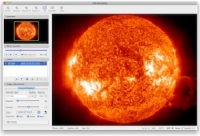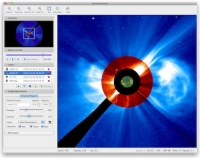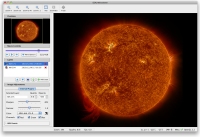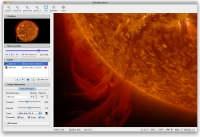ESA offers a new way of looking at the Sun
14 December 2010
ESA has released interactive, open-source software that gives both scientists and the public an unprecedented insight into the ever-changing face of the Sun. JHelioviewer allows easy access to over 14 years worth of data from the ESA/NASA Solar and Heliospheric Observatory (SOHO) along with the latest information beaming back from NASA's Solar Dynamics Observatory (SDO).
 |
|
Screenshot of the JHelioviewer user interface. Credit: ESA |
The challenge is that with this vast and ever-growing forest of data it is hard to see the wood from the trees. "If you wanted to study a phenomenon in a specific region on the Sun on a certain day then you needed to download a large volume of data and calibrate it with the appropriate software. As part of a lengthy process you'd turn it into an animated sequence, that may or may not turn out to be useful," Daniel Müller, SOHO Deputy Project Scientist, explained. "JHelioviewer is a novel way of visually browsing the archive; you can quickly identify interesting stuff and then go and get the scientific data. It greatly speeds up the process," he added.
 |
|
Overlaying data from three SOHO instruments in JHelioviewer to view solar events at multiple scales. Credit: ESA |
"All solar scales are coupled: you have small scale phenomena tying into large scale events. We now have a unique tool to tackle this hierarchy of scales," said Müller. He went on to say: "Before, you could either see the large-scale corona, or small patches on the solar surface. But you've never had the option to overlay the two and zoom in and out as you watch the Sun's activity evolve."
In this marriage of scales lies fresh potential for scientists to tackle some of the most pressing issues in modern solar physics. With more than 14 years worth of SOHO data now easy to access, users can follow the Sun's changing activity over an entire 11-year solar cycle. Alternatively, the differential rotation of the Sun can be compensated for, allowing sunspots - indicators of solar activity cycles - to be tracked as they rotate across the solar surface. Researchers can also juxtapose images of the Sun's corona, from SOHO's LASCO coronagraph, with concurrent ultraviolet data of the lower corona, provided by the EIT instrument, and MDI measurements of the magnetic field on the solar surface. This can be done with the minimum of fuss, allowing more time for the links between coronal mass ejections (CMEs) and activity on the solar surface to be explored.
 |
 |
|
Zooming in on a filament eruption near the Sun's limb (NASA SDO data). Credit: ESA | |
This leads on to the phenomenon of 'space weather': a term brought into everyday language through the pioneering work of SOHO over the last decade and a half. "JHelioviewer will help the search for the triggers or proxies that then translate into geomagnetic phenomena such as storms in Earth's magnetosphere," Müller suggested. Knowledge of such trigger mechanisms could allow Sun-watching scientists to give prior warning of such events, which have the potential to damage satellites and power grids.
And as well as opening up the Sun to solar researchers, JHelioviewer has already caught the eye of the wider scientific community. "We've already had discussions with the Mars Reconnaissance Orbiter team, as well as with the medical world, about how they might use the open-source software to analyse massive data sets in their own respective fields," Müller revealed.
However, the potential impact of JHelioviewer reaches out beyond the scientific community; the software has been specifically designed to be used by the non-expert as well. Interested members of the public have access to just the same data as the scientists and can use it to explore the Sun for themselves. "It puts millions of SOHO images at your fingertips. Anyone with a computer and internet access can use it to make a movie of how the Sun evolved over the last decade," pointed out Müller. "You could even see how the Sun looked on your birthday or Christmas; you can pick and choose whatever you like," he added.
Notes for editors
JHelioviewer has been developed as part of the ESA/NASA Helioviewer Project (Principal Investigators: Daniel Müller (ESA), Jack Ireland (ADNET Systems, Inc. / NASA Goddard Space Flight Center)) by an interdisciplinary team of solar physicists and software developers. It is based on the JPEG 2000 image compression standard and written in Java and OpenGL. The server hosting the software and related JPEG 2000 files is located at the Solar Data Analysis Center (SDAC) at NASA's Goddard Space Flight Center.
The JHelioviewer software is available to download for several operating systems. It is complemented by the website Helioviewer.org, a web-based image browser.
JHelioviewer will be presented this week at the American Geophysical Union Fall meeting, in San Francisco, USA.

